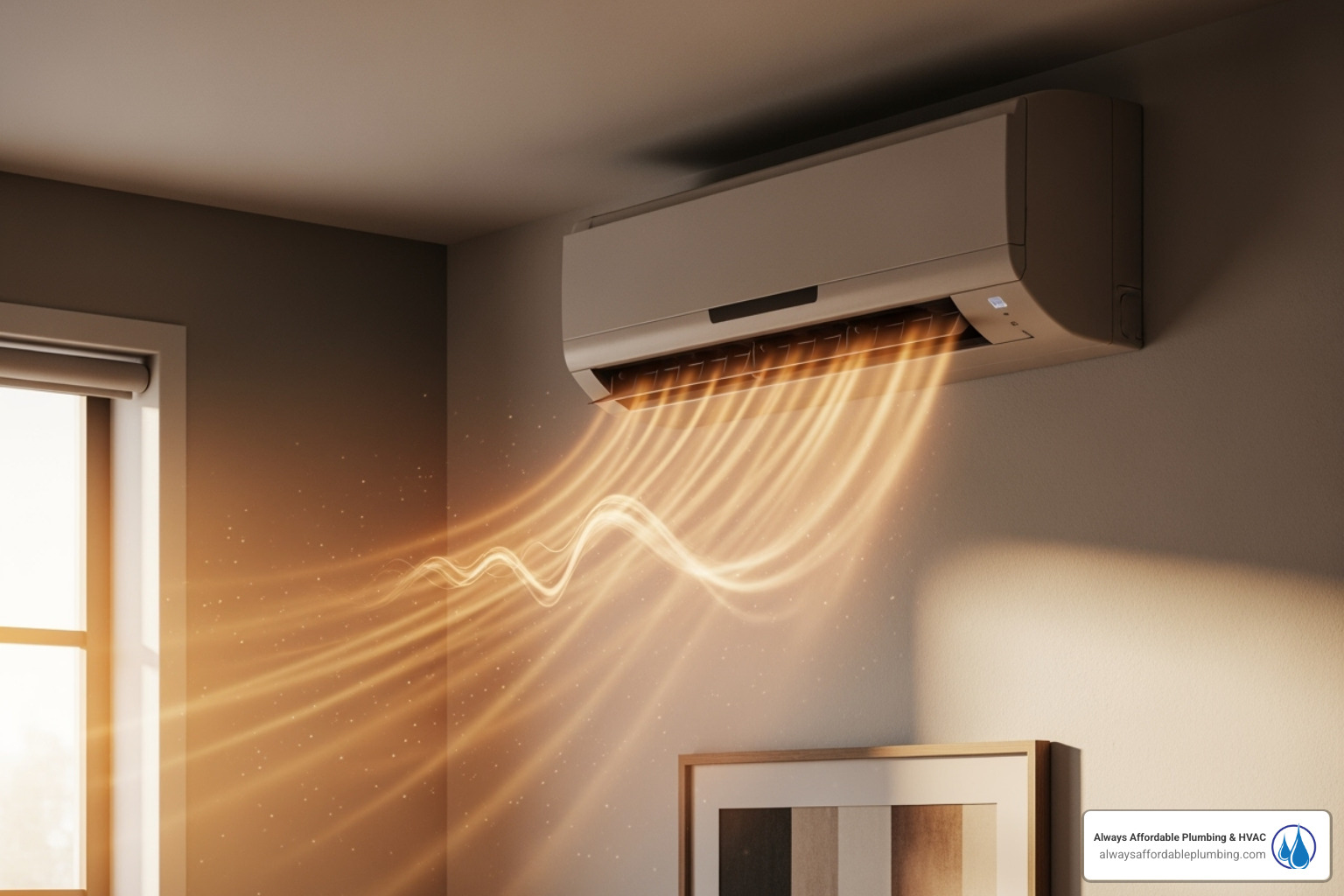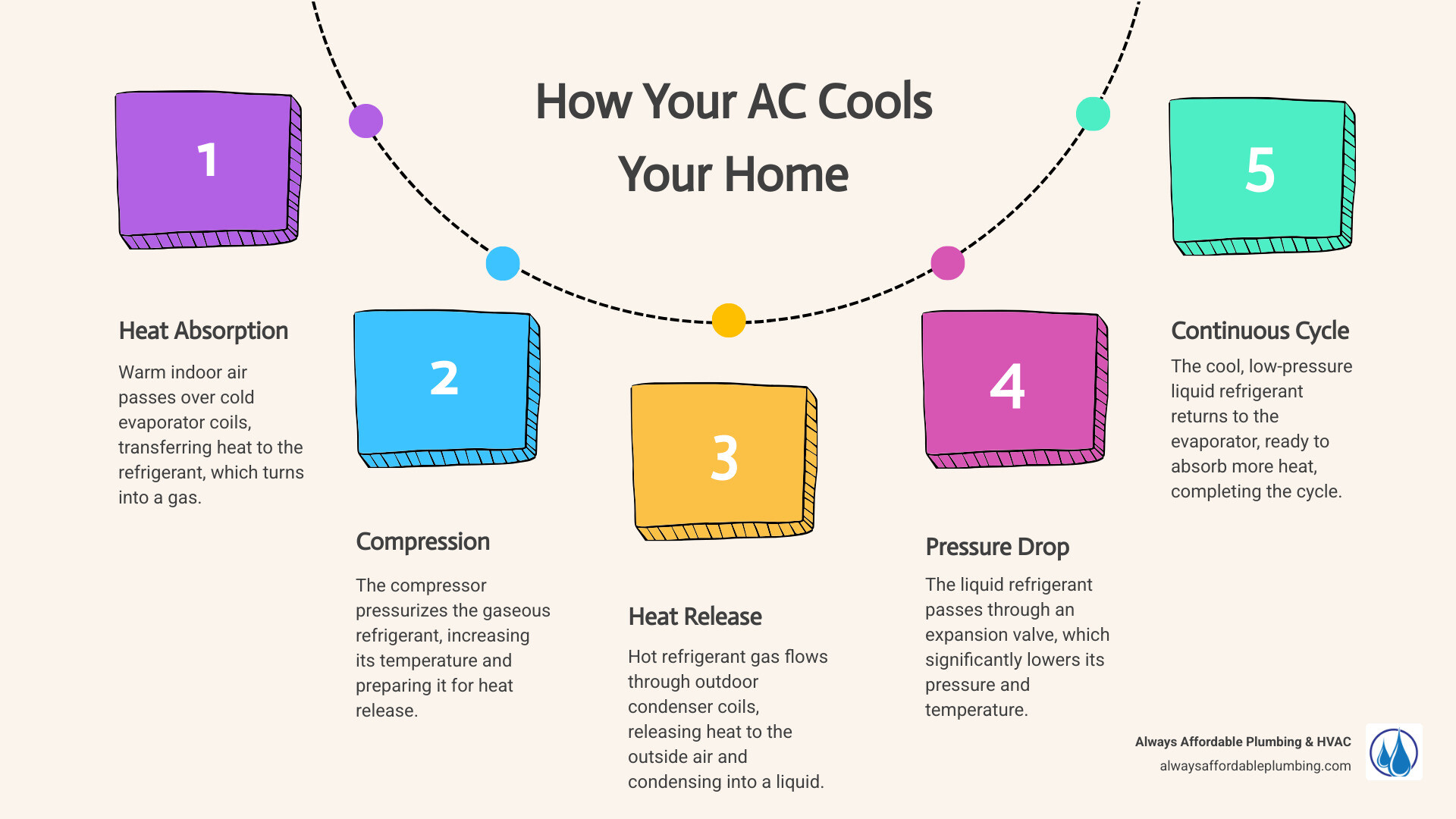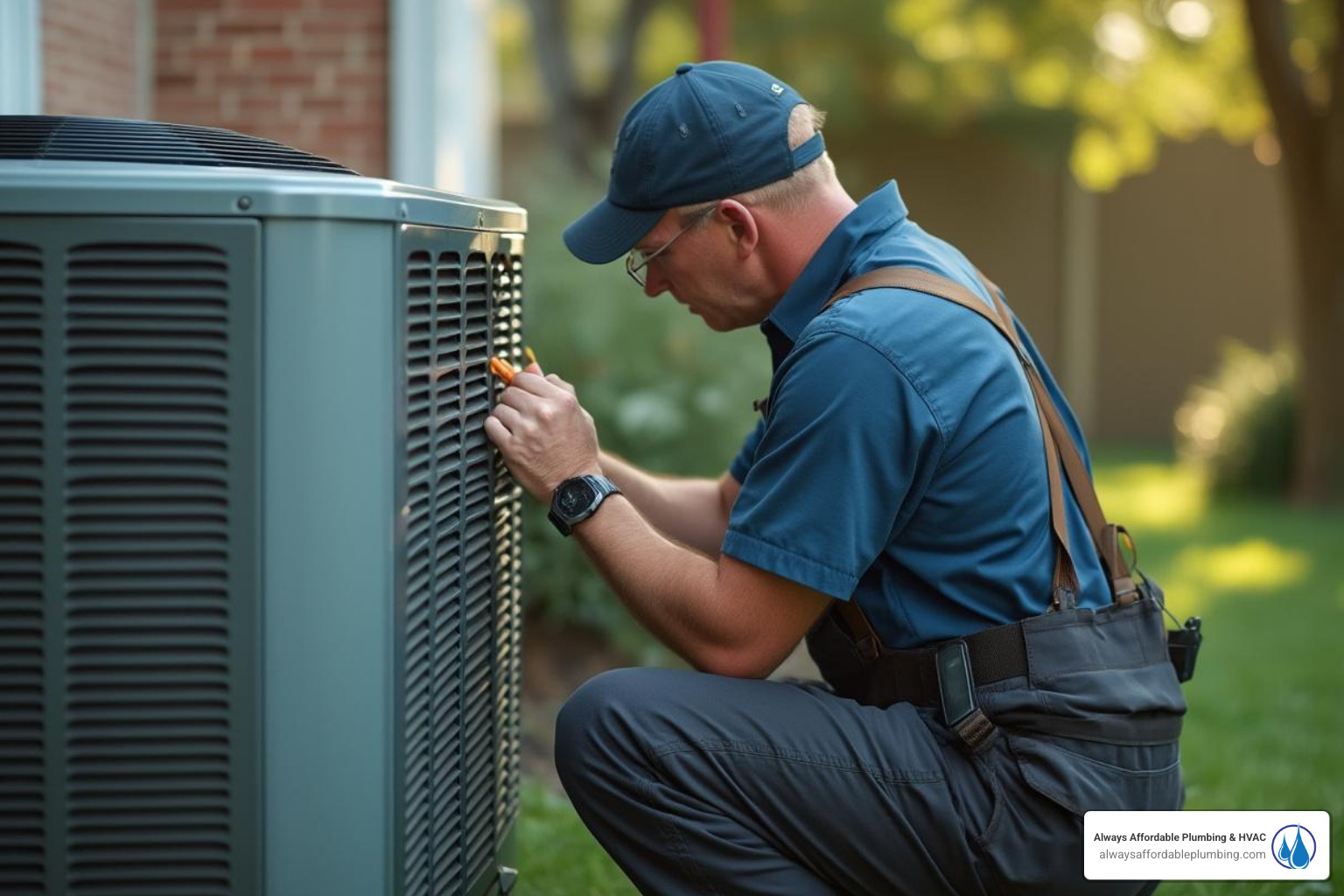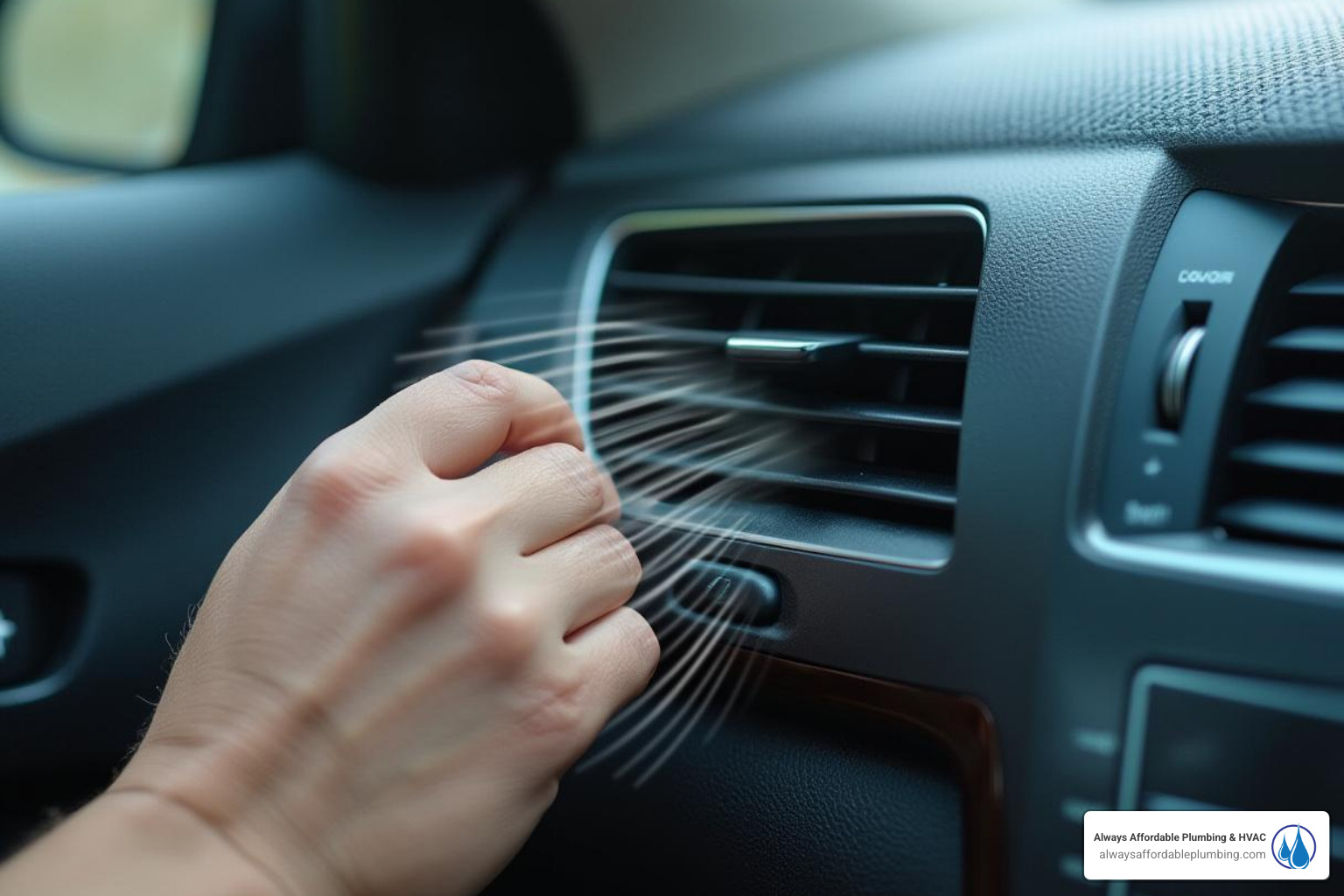
25 Aug AC Blowing Warm Air? Here’s How to Get Your Cool Back
When Your AC Lets You Down on Sacramento’s Hottest Days
Nothing’s more frustrating than cranking up your AC on a blazing Sacramento day, only to feel AC blowing warm air coming from your vents instead of the cool relief you desperately need. Whether you’re dealing with 105°F summer heat or just trying to stay comfortable at home, a malfunctioning air conditioner can quickly turn your sanctuary into an oven.
Quick Solutions for AC Blowing Warm Air:
- Check thermostat settings – Ensure it’s set to “Cool” mode, not “Heat” or “Fan Only”
- Replace dirty air filters – Clogged filters block airflow and reduce cooling
- Clear blocked vents – Remove furniture or debris from supply and return vents
- Reset tripped breakers – Check your electrical panel for tripped circuits
- Look for frozen coils – Ice buildup prevents proper heat exchange
- Inspect for refrigerant leaks – Listen for hissing sounds or check for ice on lines
The good news? Many causes of warm air from your AC are fixable with simple DIY steps. Others require professional help to avoid costly damage or safety risks.
Your air conditioner works by absorbing heat from inside your home and releasing it outside through a continuous cycle of refrigerant flowing through coils, fans, and a compressor. When any part of this system fails, you get warm air instead of cool comfort.
Simple DIY Fixes When Your AC Blows Warm Air
Before you start worrying about expensive repairs, take a deep breath. Many times when you find your AC blowing warm air, the culprit is something surprisingly simple that you can fix yourself in just a few minutes. Think of these as the “low-hanging fruit” of AC troubleshooting—easy wins that might save you a service call and get you back to comfortable living.
The truth is, we’ve seen homeowners panic over what turned out to be a thermostat setting or a dirty filter more times than we can count. Sometimes the simplest explanation is the right one, and your AC system might just need a little TLC rather than major surgery.
Check Your Thermostat Settings First
Here’s a confession from the field: we’ve driven out to “emergency” service calls only to find the thermostat was accidentally bumped to “heat” mode. It happens to the best of us, especially in busy households where kids or guests might fiddle with the controls.
Start with the basics. Make sure your thermostat is set to “Cool” mode—not “Heat” and definitely not “Fan Only.” That fan-only setting is particularly sneaky because you’ll still feel air moving, but it’s just circulating whatever temperature air is already in your ducts.
Next, check whether your fan is set to “Auto” or “On.” Here’s why this matters: when it’s set to “Auto,” the fan only runs during actual cooling cycles, so you’re guaranteed to get cooled air. But when it’s set to “On,” that fan keeps running even between cooling cycles, pushing unconditioned air around your home. That unconditioned air? It can feel surprisingly warm.
Don’t forget the simple stuff. Is your temperature setting actually lower than what your house currently feels like? Are the thermostat batteries dead? (Yes, even hardwired thermostats often have backup batteries.) And if you’ve got a smart thermostat, double-check that some automatic schedule isn’t overriding what you think you’ve set.
If your system won’t even start up, you might want to read our guide on Why AC Won’t Turn On in Heat for more troubleshooting steps.
Inspect for Clogged Air Filters and Blocked Vents
Think of your air filter as your AC’s lungs. When it gets clogged with dust, pet hair, and all the stuff floating around your Sacramento home, your system literally can’t breathe properly. This restriction doesn’t just make your AC blowing warm air—it forces the whole system to work overtime, which means higher energy bills and potential damage down the road.
Here’s the reality check: most homeowners wait way too long to change their filters. We get it—life gets busy. But during Sacramento’s intense summer months, that filter is working harder than usual. Check it monthly, and don’t be surprised if it needs changing every 30 to 90 days, especially if you have pets or anyone with allergies in the house.
A dirty filter can actually cause your evaporator coils to freeze up (we’ll talk more about that later), which definitely results in warm air instead of cool relief. You can learn more about this domino effect in our article about How Clogged Air Filters Damage AC.
But filters aren’t the only airflow culprits. Walk around your house and check both your return vents (the ones that suck air in) and supply vents (the ones that blow air out). You’d be amazed how often we find vents blocked by furniture, curtains, or that pile of laundry that was “temporarily” placed there three weeks ago.
Your AC needs clear pathways to pull warm air in and push cool air out. Even partially blocked vents can throw off the whole system’s balance and leave you wondering why certain rooms never seem to cool down properly.
Look for Tripped Breakers and Clogged Drains
Your AC system is basically running two major components: the indoor unit (with the blower fan) and the outdoor unit (with the compressor that does the actual cooling). If your indoor fan is running but you’re getting warm air, there’s a good chance your outdoor unit lost power somehow.
Start with your electrical panel. Look for any tripped breakers labeled for your AC or outdoor unit. In Sacramento’s heat, AC systems work hard and sometimes trip their breakers. Simply flip it back to “On”—but if it trips again immediately, that’s a sign of a bigger electrical problem that needs professional attention.
Don’t forget to check the disconnect switch near your outdoor unit too. Sometimes these get accidentally turned off during yard work or maintenance. It’s usually a simple flip switch in a gray box mounted on the wall near your condenser unit.
Here’s something most homeowners don’t think about: your AC doesn’t just cool air—it also removes humidity. All that moisture has to go somewhere, and it drains away through a condensate line. When that line gets clogged with algae or debris, water backs up and can trigger a safety switch that shuts down your cooling system.
You might notice water pooling around your indoor unit if this is happening. It’s your AC’s way of protecting your home from water damage, but it also means no cooling until the problem is fixed.
These electrical and drainage issues can be tricky, and there are safety considerations involved. If you’re dealing with frequent breaker trips, check out our detailed guide on When AC Trips Circuit Breaker to understand what might be going on and when to call for help.
Why Your AC is Blowing Warm Air: Deeper System Problems
While some AC issues have straightforward DIY solutions, others indicate more complex internal problems that require the expertise of a professional HVAC technician. These issues can not only cause your AC blowing warm air but also lead to more significant damage if not addressed promptly. When your AC system is acting up, it’s often a sign that something deeper is amiss.
Low Refrigerant: A Top Reason for an AC Blowing Warm Air
Think of refrigerant as the “blood” of your AC system – it’s absolutely vital for absorbing heat and humidity from your home’s air. So, if your AC is blowing warm air, low refrigerant is often the main culprit. It’s important to remember that refrigerant isn’t like car gas; it doesn’t just “run out.” If your levels are low, it almost always means you have a refrigerant leak somewhere in the system.
How can you tell? You might hear hissing sounds or even gurgling coming from your unit. Another big clue is ice forming on the refrigerant lines – those copper pipes connecting your indoor and outdoor units. When refrigerant levels are low, your AC can’t perform its heat exchange magic efficiently, which leads to weak or, you guessed it, warm airflow.
Trying to fix a refrigerant leak or “recharge” the system yourself is a big no-no. Refrigerants are chemicals that need specialized tools and know-how to handle safely. Our certified technicians at Always Affordable Plumbing & HVAC can safely locate the leak, repair it, and then properly recharge your system. Understanding the cooling process highlights just how crucial this chemical is for your comfort. For more on this, check out our page on AC Refrigerant System Recharging.
Frozen Evaporator Coils
If you peek at your indoor unit and see ice buildup on the evaporator coils, that’s a clear sign of trouble. These coils are supposed to absorb heat from your home’s air. When they freeze solid, they can’t do their job, leading to reduced cooling or, you guessed it, your AC blowing warm air. It’s like trying to drink through a frozen straw – nothing gets through!
Several things can cause these coils to freeze:
- The most common reason is poor airflow, often due to a dirty air filter, blocked return vents, or a fan that’s not working right.
- Low refrigerant (as we just discussed) can also make the coils get too cold and freeze up.
- While less common, sometimes continuous operation without a break in certain conditions can contribute to freezing.
If you find frozen coils, immediately turn off your AC unit at the thermostat. Then, switch the fan setting to “On” (if your thermostat has this option). This helps melt the ice. Make sure your air filter is clean and all vents are open. Once all the ice has completely thawed (this can take several hours), you can try restarting your AC. However, if the coils refreeze, it’s a clear sign of an underlying issue that needs professional diagnosis. Don’t let your AC freeze during the summer; find out more about Why Is AC Freezing During Summer?.
Malfunctioning Compressor
The compressor is often called the “heart” of your air conditioning system, and for good reason! Located in your outdoor unit, it’s responsible for circulating the refrigerant and increasing its pressure and temperature – a vital step in the cooling cycle. If this critical component starts failing, your AC blowing warm air is definitely a symptom.
How can you tell your compressor might be in trouble? You might hear loud noises from the outdoor unit. These aren’t just any noises; listen for distinct sounds like chattering, ticking, rattling, clicking, rumbling, grinding, or even loud banging. These sounds can point to issues with starting or internal motor problems. Another clear sign is if the outdoor unit isn’t turning on at all, even if your indoor fan is still blowing air. Even if the unit seems to be running, the airflow might be weak or warm.
A faulty compressor is a serious problem that usually requires a major repair or, in some cases, even a full unit replacement. This is absolutely not a DIY fix! If you suspect your compressor is failing, it’s crucial to call a professional HVAC technician immediately. Ignoring these signs can lead to even more damage to your entire system. Learn more about what happens when your AC Compressor Is Failing in Summer.
Leaky Ductwork
Think of your home’s ductwork as the circulatory system for your conditioned air. If there are leaks or gaps in this system, especially in parts of your home that aren’t air-conditioned (like your attic, crawlspace, or basement), it can significantly affect your AC’s performance and cause your AC blowing warm air.
Here’s why leaky ducts are such a problem:
- Loss of Conditioned Air: The cool, refreshing air your AC produces can simply escape through cracks and holes in the ducts before it ever reaches your living spaces. Energy Star estimates that leaking ducts can cause homeowners to lose roughly 20 to 30 percent of conditioned air. That’s a lot of wasted comfort and energy!
- Intrusion of Warm Air: On the flip side, unconditioned, warm air from those uncooled spaces can get sucked into your ductwork and mix with the cool air. This raises the temperature of the air coming out of your vents, making your home feel less comfortable.
- Increased Energy Bills: Your AC unit has to work much harder and longer to try and make up for the lost cool air and the incoming warm air. This means it’s running inefficiently, leading to higher energy consumption and, unfortunately, bigger energy bills.
Signs you might have leaky ductwork include uneven cooling throughout your home (some rooms are much warmer than others), dustier rooms than usual, and those nagging higher-than-usual energy bills. While small leaks might be fixed with mastic sealant or special metal tape, finding and properly sealing all leaks, especially in those hard-to-reach spots, often requires professional duct inspection and sealing services. This is certainly one of the Top Signs You Need HVAC Repair.
Is It Your Home or Car? Diagnosing Vehicle AC Issues
There’s nothing quite like sliding into your car on a scorching Sacramento day, cranking up the air conditioning, and getting… nothing. Just a sad puff of warm air. It’s just as frustrating as a home AC problem, isn’t it? While the basic idea of how an AC cools is the same (removing heat and humidity), your car’s AC system has its own unique quirks and common issues compared to the unit keeping your home comfortable.
Common Reasons Your Car AC is Blowing Warm Air
So, why is your vehicle making you sweat when you expect a refreshing blast? Here are some of the usual suspects when your car’s AC blowing warm air:
First up, just like your home system, a car refrigerant leak is a very common culprit. Refrigerant is what does the actual cooling, and if it’s low, your system can’t do its job. Vehicle AC systems are under constant vibration and stress, which can lead to hoses wearing out or seals drying over time, allowing that vital refrigerant to escape.
Next, consider a faulty car compressor. This is the heart of your car’s AC, just like in your home unit. It pressurizes the refrigerant to get the cooling process going. If it’s failing, you might hear strange noises when you turn on the AC, like a loud clunk or grinding, or it might not engage at all. Sometimes, after a long period of not being used, an older compressor might just refuse to kick in.
Another often-overlooked part is the bad condenser. This component sits at the very front of your car, usually near the radiator. Its job is to release the heat from the refrigerant. If it gets blocked by road debris – think leaves, bugs, or even plastic bags – or if it’s damaged in a minor fender bender, it can’t dissipate heat properly, leaving you with warm air.
Don’t forget the basics: blown fuses or electrical issues. A simple blown fuse can cut power to parts of your AC system. Sometimes, it’s more complex, like faulty wiring or a relay that prevents the compressor or cooling fans from getting the power they need to operate.
Speaking of fans, broken cooling fans can also be an issue. Your car has fans that pull air over the condenser to help it cool down. If these fans aren’t working, the condenser will get too hot, and your AC just won’t be able to cool the air coming into the cabin.
Finally, a dirty cabin air filter can also contribute to weak or warm airflow. Most modern cars have a filter that cleans the air coming into your vehicle’s interior. If this filter gets clogged with dust and debris, it restricts airflow, making your AC less effective and potentially causing unpleasant odors. It’s a good idea to check and replace this filter every 12,000 to 15,000 miles, or as recommended in your car’s owner’s manual.
Want a little tip to help keep your car’s AC healthy? Run your car’s AC on defrost mode for about 10-15 minutes once a week, even in winter. This helps prevent moisture buildup and keeps mold and mildew at bay. Also, keeping your car generally clean helps prevent dust and debris from clogging filters. You can dive deeper into how your vehicle’s air conditioning works with resources from Natural Resources Canada.
Home vs. Car AC: Key Diagnostic Differences
While both your home and car AC systems cool air using the same fundamental principles of refrigeration, figuring out what’s wrong with them involves different approaches. This is due to their distinct designs and the environments they operate in. Here’s a quick look at how they stack up:
| Feature | Home AC System | Car AC System |
|---|---|---|
| System Size | Large, stationary, designed for continuous operation of an entire building. | Compact, integrated into vehicle, designed for intermittent use. |
| Operating Environment | Relatively stable, usually outdoors but fixed, less vibration. | Subject to constant vibration, road debris, and extreme temperature changes. |
| Power Source | Draws significant power directly from your home’s electrical grid. | Powered by the car’s engine (via a belt) and electrical system. |
| Component Accessibility | Generally easier for technicians to access and replace larger components. | Tightly packed engine bay often makes components harder to reach. |
| Refrigerant Types | Historically R-22, now primarily R-410A (newer, more environmentally friendly). | Historically R-12, now primarily R-134a or R-1234yf (newer, more environmentally friendly). |






